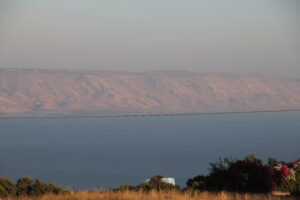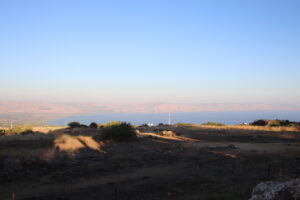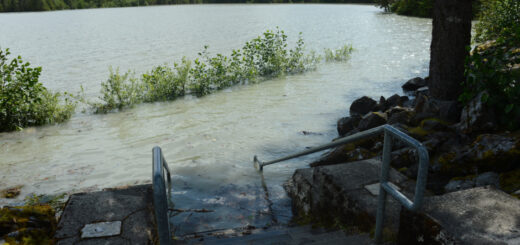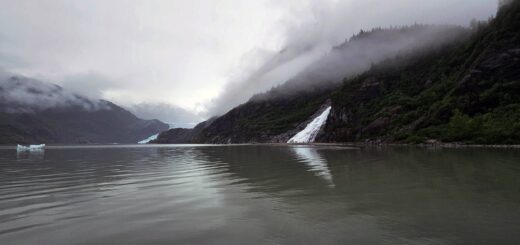Lake Kinneret, also known as the Sea of Galilee, is of great religious, cultural, and economic importance, making it a high-priority lake in terms of resource management. Part of this management relies on future climate expectations for the region. Evaporation and its resulting impacts on the overall water budget can have long-term implications for resource managers who have to sustainably balance ecosystem services, like access to clean water, food via fishing, transportation, energy generation, and other services.

Sea of Galilee, also known as Lake Kinneret or Lake Tiberius (Credit: Gary Todd via Flickr Public Domain)
As climate change’s impacts become more severe, direct atmospheric drivers of lake evaporation, like air temperature, solar radiation, and other variables, are expected to have a greater influence on evaporation rates. The localized impacts of climate change could lead to lower water levels, higher temperatures and other conditions that impact human reliance on Lake Kinneret as well as the aquatic system’s health overall.
Methods
In order to properly prepare for the future of aquatic systems, researchers across the world are working to further develop climate models. These models can run future scenarios and give an overview of likely conditions, including evaporation. While most studies utilize just a single climate model, a 2023 study published in the Journal of Hydrology sought to use multiple models to make predictions about future evaporation in Lake Kinneret, a sub-tropical lake.
The goal of the study was to investigate historical and projected evaporation conditions and evaluate key differences; assess the accuracy of the multi-model approach relative to a reference evaporation estimated using observed data; and examine future projection of lake evaporation this century using the model ensemble under different climate change scenarios.

Sea of Galilee, also known as Lake Kinneret or Lake Tiberius (Credit: Gary Todd via Flickr Public Domain)
The multi-model analysis examined five lake models forced by four different climate model projections. The four lake models used were Flake2, GLM3, GOTM4, and Simstrat5. Each model’s accuracy was tested and confirmed by comparing conducted scenarios to known historical conditions. After being validated, each model was used to make evaporation predictions for the end of the 21st century (2070-2099). The models ran three different scenarios, referred to as Representative Concentration Pathway (RCP) scenarios. The three RCP scenarios, RCP 2.6, 6.0 and 8.5, indicated low to high emission conditions, respectively.
Results
The team found the multi-model analysis was most effective when the results across all four models were averaged. In the end, all of the RCP scenarios showed an increase in evaporation rates, even in the lowest emission scenario, RCP 2.6. By the end of the 21st century, evaporation rates are predicted to increase by 9-22%, depending on emissions. The study also revealed declines in projected precipitation, leading to a water balance deficit of 14-40% this century. Paired with expected population growth, a water deficit in the Sea of Galilee would have devastating impacts on the surrounding human population and environment.
Sources
- La Fuente, S., Woolway, I., Jennings, E., Gal, G., Kirillin, G., Shatwell, T., Ladwig, R., Moore, T., Couture, R.-M., Côté, M., and Råman Vinnå, L.: Multi-model projections of evaporation in a sub-tropical lake, EGU General Assembly 2021, online, 19–30 Apr 2021, EGU21-10186, https://doi.org/10.5194/egusphere-egu21-10186, 2021.
- Mironov, D. V. 2008. Parameterization of lakes in numerical weather prediction: Description of a lake model, DWD.
- Hipsey, M. R., L. C. Bruce, C. Boon, and others. 2019. A General Lake Model (GLM 3.0) for linking with high-frequency sensor data from the Global Lake Ecological Observatory Network (GLEON). https://doi.org/10.5194/gmd-12-473-2019.
- Burchard, H., K. Bolding, and M. R. Villarreal. 1999. GOTM, a general ocean turbulence model: theory, implementation and test cases, Space Applications Institute.
- Goudsmit, G., Burchard, H., Peeters, F., Wüest, A., 2002. Application of k-∊ turbulence models to enclosed basins: The role of internal seiches. J. Geophys. Res. Oceans 107, 23–31. https://doi.org/10.1029/2001JC000954.







